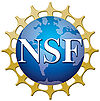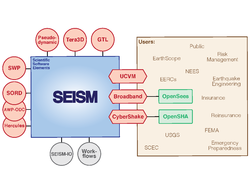Difference between revisions of "SEISM Project"
| Line 31: | Line 31: | ||
*[http://hypocenter.usc.edu/research/SEISM/scec_seism_poster_feb2014.pdf SEISM PI Meeting Poster Feb 2014] | *[http://hypocenter.usc.edu/research/SEISM/scec_seism_poster_feb2014.pdf SEISM PI Meeting Poster Feb 2014] | ||
*[http://hypocenter.usc.edu/research/SEISM/Taborda_SEISM_poster_Jan_2013.pdf SEISM PI Meeting Poster Jan 2013] | *[http://hypocenter.usc.edu/research/SEISM/Taborda_SEISM_poster_Jan_2013.pdf SEISM PI Meeting Poster Jan 2013] | ||
| + | |||
| + | == SI PI Meeting Notes == | ||
| + | *[[SI2 Meeting 2015]] | ||
== Project Overview == | == Project Overview == | ||
Revision as of 23:20, 25 February 2015
- SI2-SSI: A Sustainable Community Software Framework for Petascale Earthquake Modeling (NSF Award OCI-1148493)
Contents
Project Leadership
- PI: Thomas H. Jordan University of Southern California
- co-PI: Jacobo Bielak Carnegie Mellon University
- co-PI: Yifeng Cui University of California, San Diego
- co-PI: Kim B. Olsen San Diego State University
Project Duration
- Project Start Date: 1 August 2012
- Project End Date: 31 July 2015
Project Description on NSF Site
SEISM Open Source Scientific Software Distributions
The Software Environment for Integrated Seismic Modeling (SEISM) framework is a collection of tools that will perform seismic simulations up to 10hz. This will be accomplished by a set of compatible software tools, with tools for each function including mesh building, PSHA, deterministic, rupture, stochastic with ground motion validation framework.
SEISM currently distributes three open-source scientific software platforms:
SEISM currently provides three open-source scientific software platforms on request:
SI PI Meeting Posters
SI PI Meeting Notes
Project Overview
Recent destructive earthquakes have highlighted deficiencies in the empirical probabilistic seismic hazard analysis (PSHA). NSF-supported research by the Southern California Earthquake Center (SCEC) has developed computational pathways for improving PSHA by physics-based earthquake simulation. We are working on integrating high- and middle-level scientific software elements (SSEs) developed by SCEC into a Software Environment for Integrated Seismic Modeling (SEISM) that will be sustained as a software ecosystem for physics-based seismic hazard analysis in the United States and elsewhere. The SEISM software framework in development and funded by NSF’s SI2 program includes high-level SSEs for composing and managing unified community velocity models, SSEs for dynamic and pseudo-dynamic earthquake rupture generation, stochastic and deterministic ground motion simulation engines, and SSEs necessary to employ forward simulations in two types of inverse problems: seismic source imaging and full-3D tomography.
The SEISM framework is being developed, tested, and utilized by an interdisciplinary Cyber Science and Engineering (CS&E) team that comprises geoscientists, computer scientists, and earthquake engineers. The SEISM SSEs are being improved to be sustainable tools that include proper documentation with periodic software releases and provide users with sample models formulation, and verification and validation tests to facilitate the incorporation of better theory and data. SEISM SSEs include three major computational platforms. One, the UCVM platform will provide a framework for managing sets of seismic velocity models needed for earthquake simulations. Two, the Broadband platform will be a user-friendly interface for calculating modest suites of seismograms (< 104); it will combine deterministic methods at low-frequencies with stochastic methods that can extend seismogram synthesis above 10 Hz. Three, the CyberShake platform will use seismic reciprocity to efficiently generate the very large (> 106) suites of simulations needed for physics-based PSHA. These computational platforms will support ground motion simulation validation processes designed to move computations upward in a hierarchy that ranges from exploratory scientific research, through tested models for engineering application, to hazard products qualified for guiding urban planning, seismic design provisions in building codes, performance-based earthquake engineering, and disaster planning. These high-level SSEs of SEISM will support the use of petascale (and eventually exascale) computers by earthquake scientists, engineers, and risk managers to create a wide variety of simulation-based hazard products.
To accomplish this, we have defined a set of milestones that include the deterministic and stochastic simulation of recent earthquakes across the seismic frequency band 0-10 Hz using the Broadband platform, and testing these simulations against recorded seismograms; the production of a urban seismic hazard model for the Los Angeles region using the CyberShake platform; and the development of a time-dependent California seismic hazard model that will be driven by the time-dependent UCERF3 earthquake rupture forecast. Simultaneously, we have started the SCEC High-F project, which is designed to promote and advance deterministic earthquake systems simulation at high-frequencies (> 2 Hz). The High-F provides an avenue for interconnecting data and results from the different SEISM platforms into a common activity, and lays out ambitious scientific and computational goals which drive the scientific and software developments of SEISM’s sustainable software infrastructure.
SEISM Description
Earthquakes have major economic and societal consequences as can be seen from the aftermath of the recent large earthquakes in Japan, Chile, and New Zealand. This multidisciplinary project, which includes both geoscientists, computer scientists, and structural engineers, integrates high-level and middle-level scientific software elements developed by the Southern California Earthquake Center (SCEC) into a software environment for integrated seismic modeling that can be used for seismic hazard analysis. The framework includes integration of community velocity models, codes for dynamic and pseudo-dynamic rupture generation, deterministic and stochastic earthquake engines, and the applications necessary to employ forward simulations in two types of inverse problems: seismic source imaging and full 3D tomography. Modifications to already existing software packages slated to be significantly enhanced in the course of the workflow will allow simulations to be run on petascale machines and allow the better managing of scientific workflows. The work also focuses on software lifecycle issues such as model formation, verification, prediction, and validation and support the use of petascale computers by earthquake scientists. The goal of the project is to facilitate the incorporation of better theory and data into computationally intensive modeling of earthquake processes. Software will be designed to interface smoothly with OpenSHA, as well as OpenSEES, PEER, and NEES. Project partners will also develop and test two computational platforms, one that will have a user-friendly interface for calculating seismographs and the other will generate large suites of simulations for a layered earthquake hazard model. Models will be validated against datasets for 13 well-recorded historic California earthquakes of magnitude 6.0 or higher. The initial API will take advantage of the asynchronous IO features of Fortran 2003 with plans for adding C/C++ and Python interfaces. All codes developed will be open-source and publicly available and software distribution will be accompanied by sample input datasets and example forecast results. Broader impacts include the development of a new generation of time-dependent earthquake forecasts to produce ground-shake hazard maps, partnership with a federal agency and the private sector. It also includes a component of student and postdoctoral training and outreach to user communities. Undergraduate interns, many of whom have historically been from groups under-represented in STEM fields, will be trained in use of the software during an 8-week summer training course.

